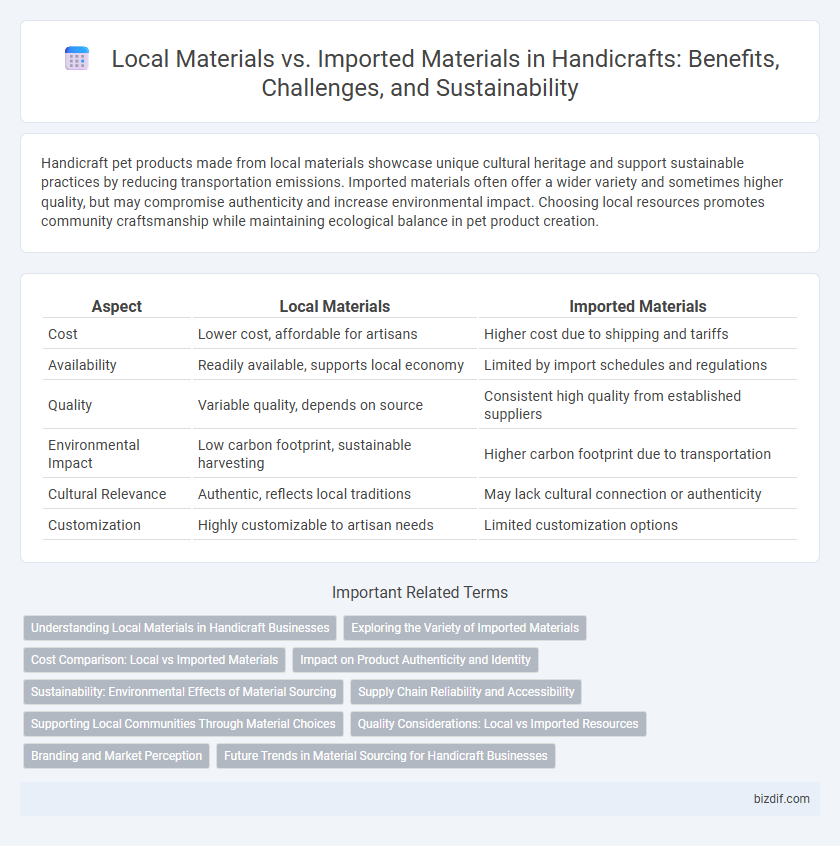Handicraft pet products made from local materials showcase unique cultural heritage and support sustainable practices by reducing transportation emissions. Imported materials often offer a wider variety and sometimes higher quality, but may compromise authenticity and increase environmental impact. Choosing local resources promotes community craftsmanship while maintaining ecological balance in pet product creation.
Table of Comparison
| Aspect | Local Materials | Imported Materials |
|---|---|---|
| Cost | Lower cost, affordable for artisans | Higher cost due to shipping and tariffs |
| Availability | Readily available, supports local economy | Limited by import schedules and regulations |
| Quality | Variable quality, depends on source | Consistent high quality from established suppliers |
| Environmental Impact | Low carbon footprint, sustainable harvesting | Higher carbon footprint due to transportation |
| Cultural Relevance | Authentic, reflects local traditions | May lack cultural connection or authenticity |
| Customization | Highly customizable to artisan needs | Limited customization options |
Understanding Local Materials in Handicraft Businesses
Local materials in handicraft businesses provide unique textures, colors, and cultural authenticity that imported materials often lack. Utilizing native resources reduces production costs and supports sustainable practices, reinforcing the economic growth of the community. Knowledge of local material properties enhances the quality and distinctiveness of handmade products, establishing competitive advantages in the global market.
Exploring the Variety of Imported Materials
Imported materials in handicraft offer artisans access to a diverse range of exotic textures, colors, and qualities that are often unavailable locally, enhancing creativity and product uniqueness. These materials include rare woods, fine silks, and specialized metals sourced from regions renowned for traditional craftsmanship, such as Italian leather or Japanese lacquer. Incorporating imported components broadens design possibilities, allowing artisans to cater to global markets and evolving consumer preferences while maintaining cultural authenticity.
Cost Comparison: Local vs Imported Materials
Local materials often offer significant cost savings in handicraft production due to reduced transportation expenses and lower import tariffs. Imported materials typically incur higher costs influenced by international shipping fees, customs duties, and currency fluctuations. Artisans frequently prefer local resources to maintain affordability and support sustainable economic development within their communities.
Impact on Product Authenticity and Identity
Using local materials in handicrafts enhances product authenticity by reflecting regional culture, traditional techniques, and natural resources unique to a specific area. Imported materials may introduce higher cost efficiency or novel textures but can dilute the cultural identity and story associated with handmade goods. Craftsmanship rooted in indigenous materials fosters a deeper connection to heritage, attracting consumers seeking genuine, place-based artistic expressions.
Sustainability: Environmental Effects of Material Sourcing
Local materials in handicraft reduce carbon emissions linked to transportation, supporting lower environmental impact and resource conservation. Imported materials often involve long-distance shipping, increasing fossil fuel consumption and ecological footprint. Sustainable sourcing prioritizes renewable, biodegradable content from local regions to minimize habitat disruption and promote eco-friendly practices.
Supply Chain Reliability and Accessibility
Local materials in handicraft ensure supply chain reliability through consistent availability and reduced lead times, minimizing disruptions and supporting timely production. Imported materials may offer diverse options but often face accessibility challenges due to customs delays, fluctuating shipping costs, and geopolitical risks. Prioritizing local sourcing enhances sustainability and strengthens community economies by leveraging accessible resources and dependable supply chains.
Supporting Local Communities Through Material Choices
Choosing local materials in handicraft production empowers regional artisans by sustaining traditional skills and generating economic opportunities within their communities. Local sourcing reduces environmental impact through lower transportation emissions, while promoting cultural heritage and authentic craftsmanship that imported materials may lack. Supporting local supply chains strengthens community resilience and fosters sustainable development in the artisanal sector.
Quality Considerations: Local vs Imported Resources
Local materials in handicraft often offer superior quality due to their natural compatibility with traditional techniques and environmental conditions, ensuring durability and authenticity in the finished products. Imported materials may provide access to unique textures and innovative properties, but they sometimes sacrifice consistency and may lack the cultural resonance inherent in local resources. Evaluating quality considerations involves balancing the authenticity and sustainability of local materials with the specialized characteristics and global trends presented by imported resources.
Branding and Market Perception
Local materials in handicrafts often enhance brand authenticity and appeal by showcasing regional heritage, which resonates strongly with consumers seeking unique, culturally rich products. Imported materials may offer broader design possibilities but risk diluting brand identity if perceived as less connected to the craft's origin. Market perception tends to favor handcrafted items using indigenous resources, associating them with higher value, sustainability, and genuine craftsmanship.
Future Trends in Material Sourcing for Handicraft Businesses
Future trends in material sourcing for handicraft businesses reveal a growing preference for sustainable, locally sourced materials that support regional economies and reduce carbon footprints. Innovations in biodegradable and eco-friendly raw materials are driving demand away from traditional imported sources, aligning with increased consumer awareness about environmental impact. Handicraft artisans are expected to leverage advanced supply chain technologies that enhance transparency and traceability, boosting the appeal of authentic, locally crafted products worldwide.
Local Materials vs Imported Materials Infographic

 bizdif.com
bizdif.com